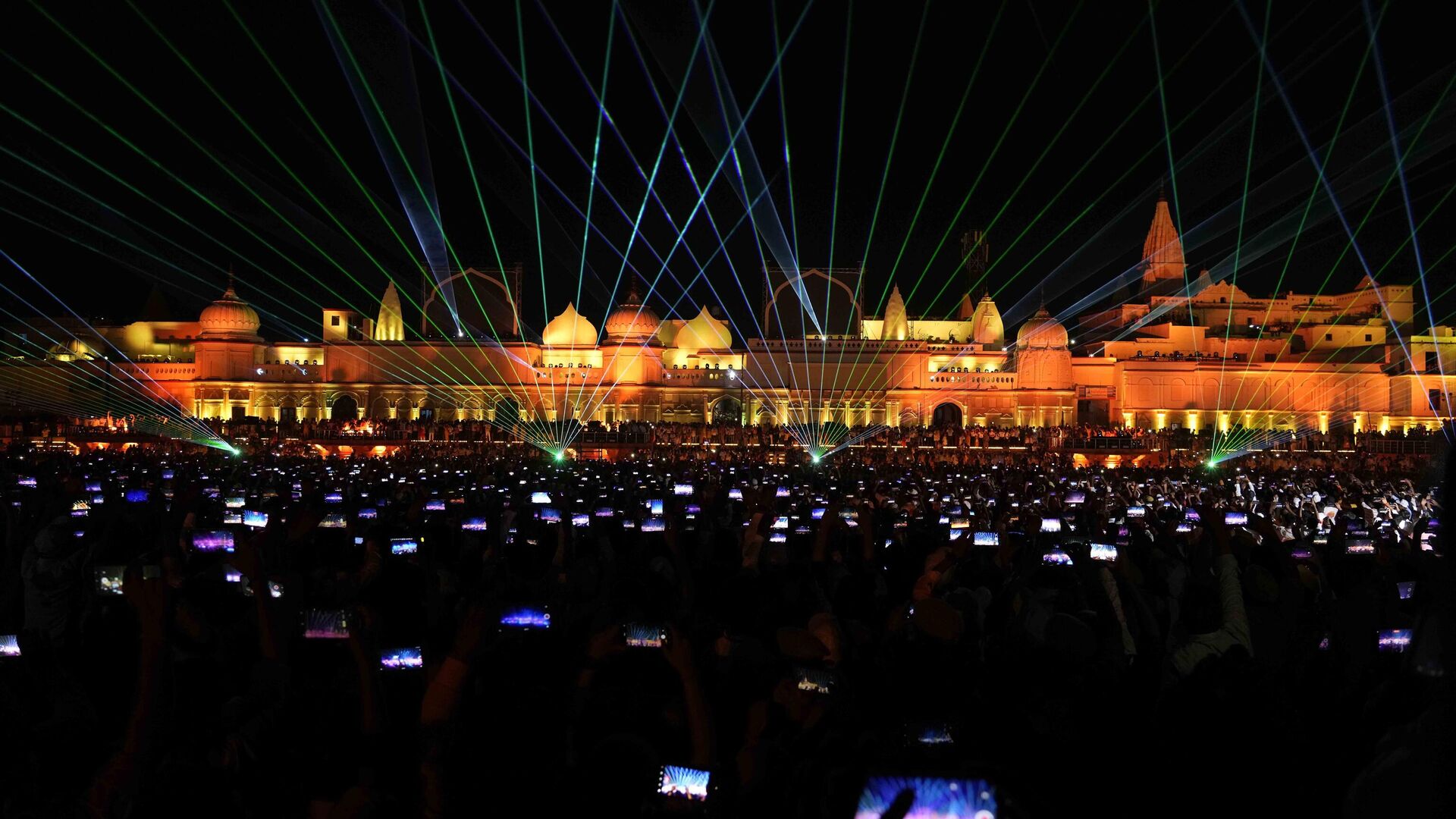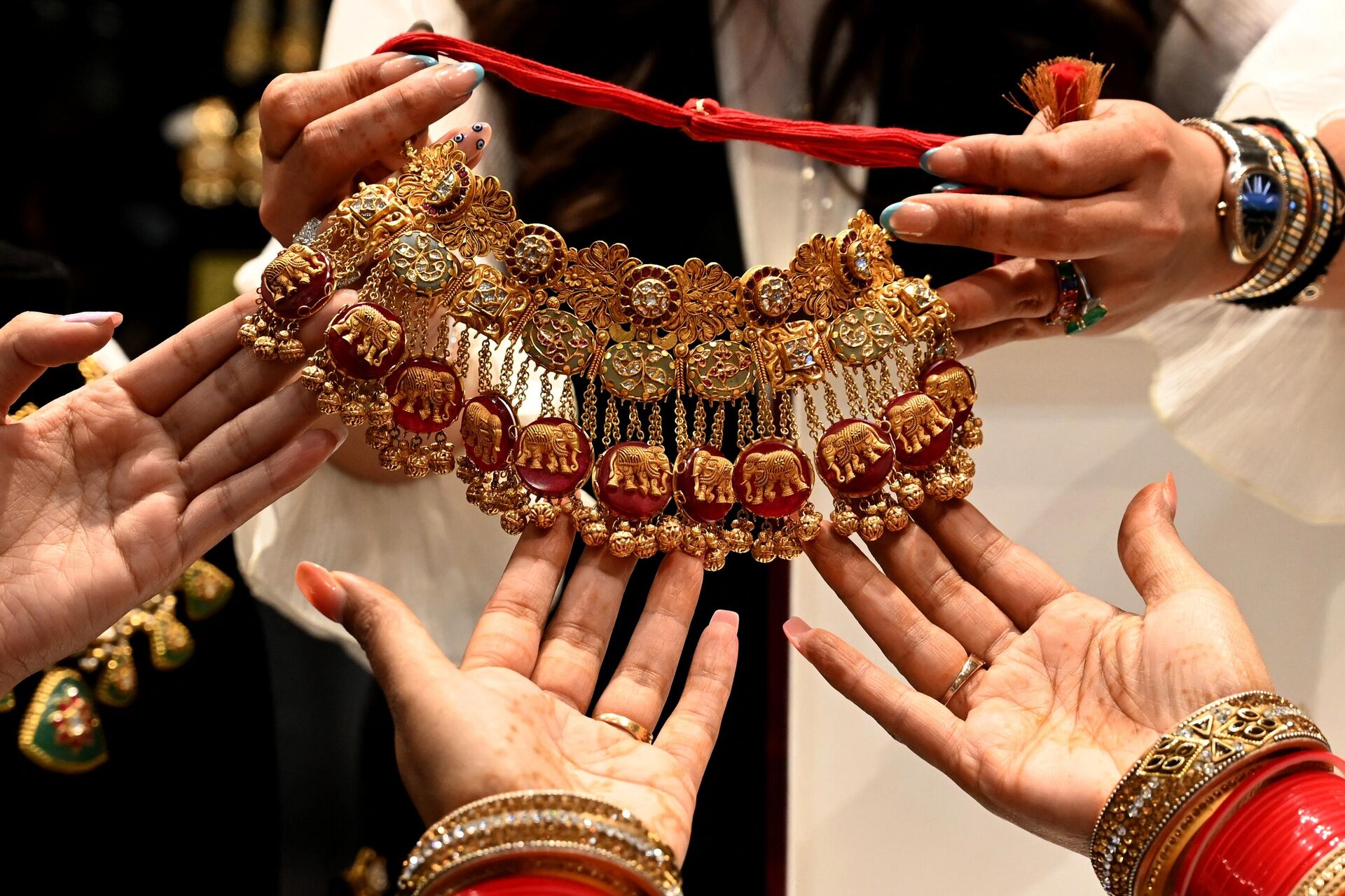https://sputniknews.in/20231110/why-is-diwali-celebrated-with-firecrackers-5337286.html
Why is Diwali Celebrated With Firecrackers?
Why is Diwali Celebrated With Firecrackers?
Sputnik India
Diwali, the grandest annual celebration for Hindus, widely recognised as the festival of lights, captivates billions of people worldwide with its splendour.
2023-11-10T21:03+0530
2023-11-10T21:03+0530
2023-11-10T21:03+0530
india
delhi
uttar pradesh
diwali
hindu
hindu deities
hindu devotees
hindu festival
hinduism
culture
https://cdn1.img.sputniknews.in/img/07e7/0b/09/5321651_0:160:3072:1888_1920x0_80_0_0_a6f1292456bc8b018ba47941f569ca23.jpg
The festival of Diwali, symbolising the "victory of light over darkness, good over evil and knowledge over ignorance", is a grand celebration that dates back thousands of years.It commemorates the return of Lord Rama to the historic city of Ayodhya, in the Indian state of Uttar Pradesh, after a challenging and arduous 14-year exile.Lord Rama triumphantly rescued his wife, Goddess Sita, by killing the ten-headed demon king, Ravana. Hence, the festival represents the victory of good over evil.Lakshmi Puja is an important ritual performed by people on this festival. It is believed that Goddess Lakshmi, the divine embodiment of wealth and prosperity, graciously visits the homes of her devotees and bestows abundant blessings and immense fortune on them on this day.Traditionally, Hindus exchange sweets with friends and relatives, decorate their homes, buy jewellery, utensils and clothes. They illuminate homes and streets with artificial lights and diyas (earthen oil lamps) and burst crackers with loved ones as part of the festivities.Diwali Firecrackers HistoryFireworks, a common and inseparable part of Diwali celebrations, have not always been used on this occasion.Historically, gunpowder first came to India around 1400 AD for warfare, wrote the late historian P.K. Gode in his book titled "History of Fireworks in India between 1400 and 1900".In 1518, fireworks were used at a wedding in Gujarat. However, their use was restricted to esteemed members of the royal families and only on rare and special occasions.Around the 1700s, fireworks became a sign of royalty and wealth, and their use was limited to weddings and coronations.It was only after Indian independence in 1947 that common people started using fireworks during Diwali.Diwali and Firecrackers DebateIn recent years, the bursting of crackers has been banned during Diwali, especially in Delhi, due to their negative impact on air pollution levels and the deterioration of the Air Quality Index.In 2016, the Chest Research Foundation observed that certain fireworks emitted particulate matter (PM) that far exceeded the limit set by the World Health Organization (WHO).Later, many studies and experts warned that firecrackers release toxic gases like nitrogen dioxide, sulphur dioxide, carbon monoxide, and others and have a detrimental impact on health, causing an array of ailments – respiratory problems (asthma), allergies, lung infections and even heart attacks.As air quality in Delhi generally degrades around Diwali, bursting firecrackers have been banned in Diwali since 2017.This year, the Supreme Court has urged all states and Union Territories to comply with its orders of imposing curbs on bursting firecrackers during Diwali. However, the top court has not banned bursting of firecrackers on Diwali, except for in Delhi.
https://sputniknews.in/20231109/when-is-diwali-in-2023-5316397.html
india
delhi
uttar pradesh
Sputnik India
feedback.hindi@sputniknews.com
+74956456601
MIA „Rossiya Segodnya“
2023
Deexa Khanduri
https://cdn1.img.sputniknews.in/img/07e6/0c/13/138923_52:0:533:481_100x100_80_0_0_cadf23d341691fc65ff2b22fd1afe584.jpg
Deexa Khanduri
https://cdn1.img.sputniknews.in/img/07e6/0c/13/138923_52:0:533:481_100x100_80_0_0_cadf23d341691fc65ff2b22fd1afe584.jpg
News
en_IN
Sputnik India
feedback.hindi@sputniknews.com
+74956456601
MIA „Rossiya Segodnya“
Sputnik India
feedback.hindi@sputniknews.com
+74956456601
MIA „Rossiya Segodnya“
Deexa Khanduri
https://cdn1.img.sputniknews.in/img/07e6/0c/13/138923_52:0:533:481_100x100_80_0_0_cadf23d341691fc65ff2b22fd1afe584.jpg
diwali 2023, diwali, happy diwali, diwali 2023 date, happy diwali wishes, diwali wishes, diwali rangoli, happy diwali images, rangoli design for diwali, diwali kab hai, rangoli for diwali, diwali images, rangoli designs for diwali, diwali wishes in hindi, diwali drawing, kabhi eid kabhi diwali, happy diwali wishes 2023, diwali rangoli designs, diwali wishes in english, diwali quotes, 2023 diwali date, diwali wishes in marathi, dev diwali 2023, diwali date, happy diwali wishes in hindi, when is diwali in 2023, essay on diwali, diwali background, diwali kab ki hai, diwali rangoli design, happy diwali images 2023, diwali decoration ideas, diwali wishes images, diwali puja time 2023, diwali puja time, when is diwali, diwali crackers, diwali essay, diwali photo, diwali status, 2023 diwali date, happy diwali 2023, diwali greetings, diwali puja 2023, diwali in 2023, diwali kab hai 2023
diwali 2023, diwali, happy diwali, diwali 2023 date, happy diwali wishes, diwali wishes, diwali rangoli, happy diwali images, rangoli design for diwali, diwali kab hai, rangoli for diwali, diwali images, rangoli designs for diwali, diwali wishes in hindi, diwali drawing, kabhi eid kabhi diwali, happy diwali wishes 2023, diwali rangoli designs, diwali wishes in english, diwali quotes, 2023 diwali date, diwali wishes in marathi, dev diwali 2023, diwali date, happy diwali wishes in hindi, when is diwali in 2023, essay on diwali, diwali background, diwali kab ki hai, diwali rangoli design, happy diwali images 2023, diwali decoration ideas, diwali wishes images, diwali puja time 2023, diwali puja time, when is diwali, diwali crackers, diwali essay, diwali photo, diwali status, 2023 diwali date, happy diwali 2023, diwali greetings, diwali puja 2023, diwali in 2023, diwali kab hai 2023
Why is Diwali Celebrated With Firecrackers?
Deexa Khanduri
Sputnik correspondent
Diwali, the biggest annual festival for Hindus, is widely known as the festival of lights. As millions are drawn to its splendour, Sputnik explores why firecrackers are part of it.
The festival of Diwali, symbolising the "victory of light over darkness, good over evil and knowledge over ignorance", is a grand celebration that dates back thousands of years.
It commemorates the return of Lord Rama to the historic city of Ayodhya, in the Indian state of Uttar Pradesh, after a challenging and arduous 14-year exile.
Lord Rama triumphantly rescued his wife,
Goddess Sita, by killing the
ten-headed demon king, Ravana. Hence, the festival represents
the victory of good over evil.Lakshmi Puja is an important ritual performed by people on this festival. It is believed that Goddess Lakshmi, the divine embodiment of wealth and prosperity, graciously visits the homes of her devotees and bestows abundant blessings and immense fortune on them on this day.
Traditionally, Hindus exchange sweets with friends and relatives, decorate their homes, buy jewellery, utensils and clothes. They illuminate homes and streets with artificial lights and diyas (earthen oil lamps) and burst crackers with loved ones as part of the festivities.
Diwali Firecrackers History
Fireworks, a common and inseparable part of Diwali celebrations, have not always been used on this occasion.
Historically, gunpowder first came to India around 1400 AD for warfare, wrote the late historian P.K. Gode in his book titled "History of Fireworks in India between 1400 and 1900".
In 1518, fireworks were used at a wedding in
Gujarat. However, their use was restricted to esteemed members of the royal families and only on rare and special occasions.
Around the 1700s, fireworks became a sign of royalty and wealth, and their use was limited to weddings and coronations.
It was only after Indian independence in 1947 that
common people started using fireworks during Diwali.
Diwali and Firecrackers Debate
In recent years, the bursting of crackers has been banned during Diwali, especially in Delhi, due to their negative impact on air pollution levels and the deterioration of the Air Quality Index.
In 2016, the Chest Research Foundation observed that certain fireworks emitted particulate matter (PM) that far exceeded the limit set by the World Health Organization (WHO).
Later, many studies and experts warned that firecrackers release toxic gases like nitrogen dioxide,
sulphur dioxide, carbon monoxide, and others and have a detrimental impact on health, causing an array of ailments – respiratory problems (asthma), allergies, lung infections and even heart attacks.
As air quality in Delhi generally degrades around Diwali, bursting firecrackers have been banned in Diwali since 2017.
This year, the Supreme Court has urged all states and Union Territories to comply with its orders of imposing curbs on
bursting firecrackers during Diwali. However, the top court has not banned bursting of firecrackers on Diwali, except for in Delhi.




